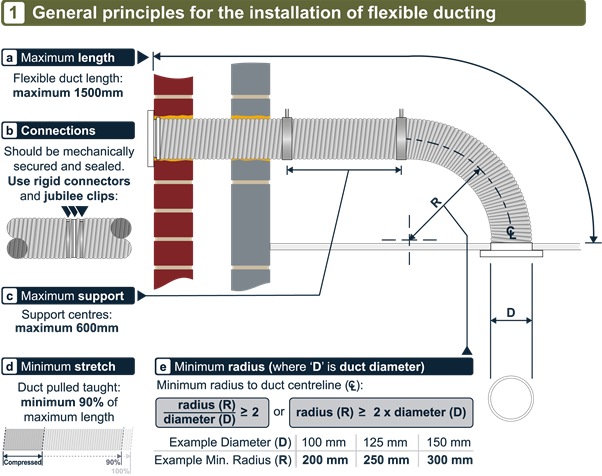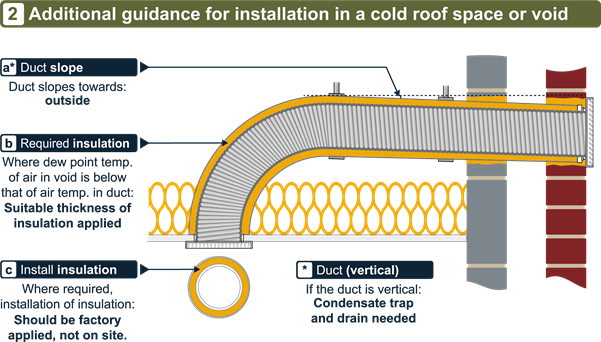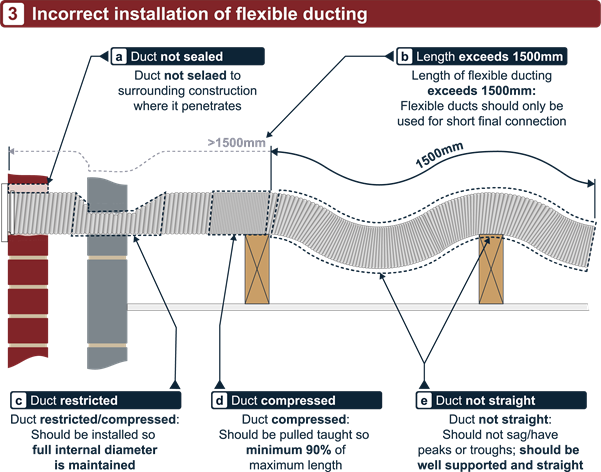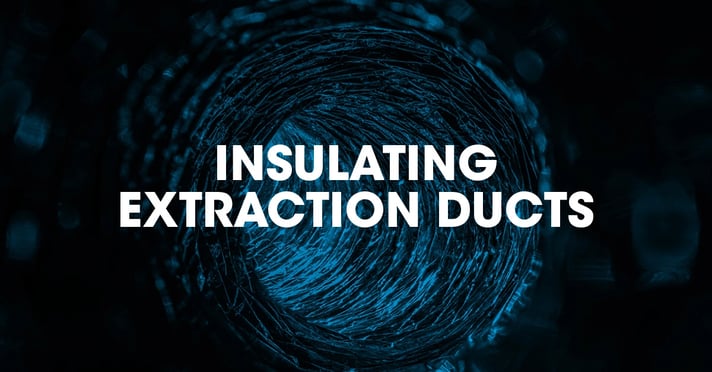Installation of flexible ducts in dwellings
Incorrect installation of ducting can result in an ineffective ventilation strategy affecting the health and convenience of occupiers, or damage the building fabric.
If ducts are not fitted correctly, the required extract rates might not be achieved upon testing/commissioning. This may lead to costly and intrusive remedial works to correct non-compliance with Requirement F1 of the Building Regulations in England or Wales or Standard 3.14 within the Building Standards Technical Handbook – Domestic (6), that supports the Building (Scotland) Regulations 2004.
Poor installation can also result in collection of dirt/debris, condensation and excess energy use. Therefore, it is critical that ducts for any ventilation system are in accordance with Building Regulation statutory guidance and any additional requirements of the Technical Manual.
Note: The following information is based on guidance provided in support of Building Regulations valid from June 2022 in England.
Although similar, different minimum requirements may apply to Wales and Scotland and should be reviewed following relevant guidance.
Where they pass through a cold space, flexible ducts should be factory insulated to avoid condensation. Guidance on the standards to be achieved can be found in BSRIA BG 43/2013: A guide to specification, procurement, installation and maintenance.
General good practice installation guidance is shown in diagram 1 of this article, with additional guidance in diagram 2 for when ducts are installed through a cold space.
The principles of incorrect installation are shown in diagram 3.
Diagram 1

Solid ducts should be used for all installations, and flexible ducts may be used as a final connection if necessary. Where necessary, flexible ducts must be installed using the principles of diagram 1:
1a. Flexible ducts should be used as a final connection only and not exceed 1500mm in length.
1b. Connections should be mechanically secured and sealed. Rigid connectors and jubilee clips are needed to ensure a good seal and prevent leaks.
1c. Adequate support is required at centres not exceeding 600mmA, ensuring the duct is straight without any peaks or troughs.
1d. Flexible ducting must be pulled taught so that it is at least 90% of its maximum length
1e. Bends should be avoided. If necessary, the minimum radius to the centreline of the duct is twice the nominal diameter of the duct (Radius/Duct Diameter is greater than 2)
Diagram 2

If a duct is installed within or through a cold (unheated) space; the guidance in diagram 2 should be followed in addition to that of diagram 1:
2a. BR 262 (1) states that ducts slope towards the outside to allow safe removal of condensate. If the duct is installed vertically, a condensate trap with a separate pipe to drain is required B.
2b. A suitable thickness of insulation should be provided to the duct where the dew point temperature of the surrounding air in the void is below that of the air temperature C in the ductwork. BRE Report 262 (1) recommends that material giving a thermal resistance of at least 0.6 m²K/W is used.
2c. Insulation should be factory applied and not fitted to the duct on site
Diagram 3

Diagram 3, above, shows some incorrect installation methods:
3a. Leaving gaps between a duct and any surrounding construction compromises the airtightness and moisture resistance. All gaps should be sealed between the duct penetrations and surrounding construction in any wall, floor or roof to ensure the air and moisture barrier is maintained.
3b. The length of the flexible duct must not exceed 1500mm and only used for short final connections.
3c. If the full diameter of the duct is not maintained, resistance to air flow is created which can impact on the performance of the ventilation system. Ensure that the ductwork does not pass through holes with a smaller diameter than the duct.
3d. Ensure that the duct is pulled taught, do not install the duct compressed. The duct should be pulled taught so that it is a minimum 90% of its maximum length D.
3e. The duct should be installed straight so that it does not sag between joists or other constructions. Ducting should be suitably supported at maximum 600mm centres
References:
- Building Research Establishment, BRE. BR 262 Thermal Insulation: Avoiding Risks. Garston, Watford : Construction Research Communications Ltd, 2002. BR 262.
- HM Government. Approved Document F: Ventilation, Volume 1: Dwellings. [Online] Available at: www.gov.uk : RIBA Books, 2021. ADFv1 2021.
- Hawkins, Glenn. Flexible Ductwork - A guide to specification, procurement, installation and maintenance. Bracknell : BSRIA , 2013. BG 43/2013.
- Welsh Government. Approved Document C: Site preparation and resistance to contaminants and moisture. [Online] Available at: www.gov.wales : Welsh Government, 2017. ADC (Wales) 2004 Edition, Amended 2010, 2013 & 2017.
- HM Government. Approved Document C: Site preparation and resistance to contaminants and moisture. [Online] Available at: www.gov.uk : NBS, 2013. ADC (E) 2004 Edition, Amended 2010 & 2013.
- Scottish Government. Building Standards Technical Handbook 2022: Domestic
A Approved Document F: Ventilation (2021) (2) in England references compliance with the standards in BSIRA BG 43/2013 (3) for flexible ducts, containing these installation requirements.
B Approved Document C: Site preparation and resistance to moisture and contaminants in England (2004, amended 2010 and 2013) (5) and Wales (2004, amended 2010, 2013 and 2017) (4) references guidance contained in BR 262 (1).
C Approved Document F: Ventilation (2021) (2) in England references compliance with the standards in BSIRA BG 43/2013 (3) for flexible ducts, containing these installation requirements.
D Approved Document F: Ventilation (2021) (2) in England references compliance with the standards in BSIRA BG 43/2013 (3) for flexible ducts, containing these installation requirements.

